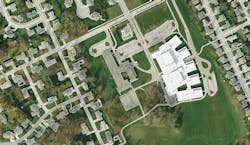Lidar and High-Resolution Imagery Offer Fair, Defensible Stormwater Billing
When customers ask utility companies for explanations about their bills, what usually happens? The company tries to provide a fair justification to defend the fee. However, in some cases, a fair defense does not exist. Need an example? Consider stormwater fees. These bills often look identical across residential properties within the same jurisdiction and do not fully reflect what a commercial property owner should pay. A fair defense is not possible in this situation if a government entity has not approved of a utility company’s calculation method, but that does not mean a fair justification is altogether impossible.
Utility companies have an opportunity to provide fair, defensible stormwater fees. However, that opportunity may depend on their willingness to toss aside the long-used equivalent residential unit (ERU) calculation.
For decades, the ERU method has helped utility companies determine stormwater fees for residents and commercial property owners. Utility companies estimate the average impervious surface area of a single-family home in a specified jurisdiction—the standard ERU. Then, commercial property owners are assessed stormwater fees based on the number of ERUs (Equivalent Residential Unit) that could fit within their lots. The resulting stormwater bills are equitable, but not fair and defensible without a government entity’s approval.
"If I live in a 10,000-square-foot home with a swimming pool, tennis court and basketball court and am paying the same as a family who lives in a mobile home down the road, that's not fair," said Jon Gustafson, Woolpert director of artificial intelligence. "Alternatively, maybe our properties are the same size, but I have less impervious surface. If we're both getting the same stormwater bill, it's equitable but not fair or defensible. This doesn't mean that utility companies are doing something wrong intentionally; providing a fair and defensible fee hasn't always been possible."
Historically, the lack of accurate data and advanced technology has hindered utility companies from determining and delivering personalized stormwater bills, leaving the ERU as the next-best solution. Fortunately, times are changing, and the evolution of high-resolution imagery and lidar data has transformed what is possible for utility companies that want to provide fair, defensible fees. In addition, machine learning technologies have recently been patented to employ artificial intelligence and deep learning technologies, algorithms and workflows. These integrate disparate data from multiple sources to achieve the highest possible geographic accuracies.
Utility Companies, Meet Lidar and High-resolution Imagery
Lidar is a remote sensing method that uses a pulsed laser to measure variable distances to the earth. The pulses combine with other remote sensing data to generate accurate 3D information about the earth's shape and its natural and artificial characteristics.
When utilized by utility companies, lidar data can help create the resource needed to calculate fair, defensible billing: impervious surface maps. Lidar-based impervious surface maps measure and display nonporous surfaces to help utility companies fairly distribute stormwater fees, maintenance efforts and capital expenditures. However, high-quality impervious surface maps do not rely on lidar data alone. High-resolution aerial imagery is key in determining the precise locations and number of impervious surfaces in any given area.
"Over the years, we've started seeing more imagery being collected digitally that used to be collected with film cameras before being scanned," Gustafson said. "That collection method didn't provide the wavelength information (inherent in light) to help us identify what is, for example, a parking lot versus grass. But now that digital cameras or sensors can collect this imagery, it's possible to leverage the digital values of every pixel within an image, combine it with lidar point cloud data and extract precise information about impervious surface areas as well as their heights above ground."
This insight offers an in-depth look at the construction plane based on two datasets: a disparate, 2D dataset and a 3D dataset inspired by lidar. Together, these datasets create a super derivative dataset that supports the extraction of pertinent information regarding impervious surfaces and improves the ability to calculate fair, defensible stormwater fees for residents and commercial property owners alike.
Dividing Land Divides Bills
Here is an example to illustrate how this process works.
Start by thinking about the geographical area a utility company might service. This area could include an entire county or city or even multiple jurisdictions. In each case, differing geographies may make the picture seem vast and disparate. Fortunately, high-resolution imagery and lidar data make that view more approachable by dividing the geography into distinct, homogenous zones.
For instance, perhaps the example area has two urban neighborhoods, a few rural neighborhoods and some woodlands. An impervious surface map will divide this area into homogenous zones to help utility companies approach each zone separately and uniquely. This separation is imperative because urban communities look very different from rural neighborhoods; the former has more impervious surface area than the latter, and high-resolution imagery and lidar data can highlight that to ensure the map accurately represents the area's natural and artificial features.
With those delineations in place, other advanced technologies can then subdivide the homogenous areas into individual parcels. From there, it is a relatively simple process to calculate the impervious surface of each parcel as well as its applicable fee. Sometimes, however, parcels are not directly tied to the customers who need to be billed, requiring one more step in the process.
"Think of a strip mall or a condominium," Gustafson said. "It's usually one parcel with shared ownership or different businesses renting portions of the parcel area, so it’s not immediately clear who should be billed and how. The parcel information doesn't always provide the final outcome. The real outcome is a customer ID with an actual number, one that signifies how much impervious surface a specific customer is responsible for. From there, it's easy to create a straightforward billing table."
This highly detailed billing table does not look the way that many current billing tables do, with consistent fees across the board. Instead, the advanced billing table includes a personalized stormwater fee for each customer.
Agnostic & Timely Data
Impervious surface maps that generate custom stormwater fees can be a reality when high-resolution imagery and lidar data are the engines powering it, but every engine needs the right fuel to provide the best result. These maps offer exceptional insight when they are fueled by a single source for imagery and lidar data. However, they can provide even better insight when fueled by agnostic and current data. What does that mean?
An impervious surface map that operates on agnostic data integrates metrics from various sources. It is not limited to a single source of data if other sources are available. Additionally, an impervious surface map that operates on current data “notices” changes in the number and nature of impervious surfaces on individual parcels to ensure fees are recalculated accordingly.
"Perhaps someone builds a new home, or their business replaces a parking lot with green space," Gustafson said. "An impervious surface map that relies on current data will reflect that change as soon as it's practical. Then, utility companies can charge for what actually exists, which isn't possible with sporadic ERU recalculations."
Under the ERU method, utility companies measure property owners’ lots periodically—sometimes with up to 30 years between measurements. When customers alter their landscapes, changes may not be reflected on stormwater bills until they request remeasuring from the utility company. However, utility companies can sidestep this process by using current imagery and lidar data to fuel their impervious surface maps, guaranteeing that their customers receive fair, defensible stormwater fees consistently.
The Million-dollar Benefit
Providing a justifiable stormwater fee is a significant benefit of using impervious surface maps, but these maps can also offer a million-dollar benefit that must be mentioned: additional incoming revenue that utility companies can use to construct, operate and maintain stormwater systems.
Aggressive land development combined with aging and neglected infrastructure have increased pressure on stormwater systems. In 1995, the Environment“A true per-parcel billing rate can often lead to additional stormwater fees,” said Sam Moffat, Woolpert geospatial program director. “Even small changes can translate into millions of additional fees for stormwater management programs. These maps also provide a faster turn-around and cost less than traditional impervious surface mapping tools, so the return on investment is always big.”
That significant ROI (Return on Investment) can help utility companies accelerate improvements to stormwater systems and resilience projects, delivering increased safety to their communities.
Out With the Old, in With the New
The ERU calculation has provided an equitable path to handling stormwater costs, and until recently, it has been the best solution for determining bills that account for customers' potential impervious surfaces. Now, high-resolution imagery and lidar data are paving the way to a new approach that empowers utility companies to provide customized billing.
With access to impervious surface maps, utility companies can divide jurisdictions into homogenous areas, subdivide those areas into individual parcels and then calculate customer bills based on actual impervious surfaces. It is a high-tech yet neutral way of billing that generates fair and defensible stormwater fees.
Daniel Ngoroi, is Woolpert Geospatial Specialist and Senior Associate
About the Author
Daniel Ngoroi
Geospatial Specialist and Senior Associate
Woolpert Geospatial Specialist and Senior Associate, Daniel Ngoroi, works out of Woolpert’s Dayton, Ohio, headquarters.


